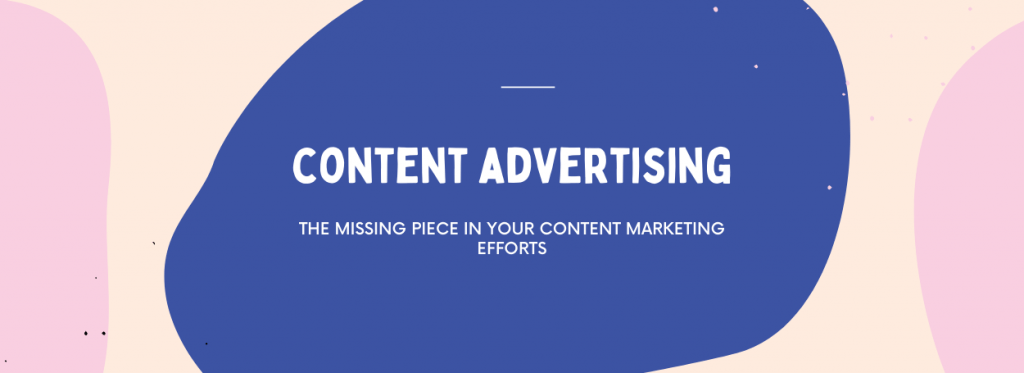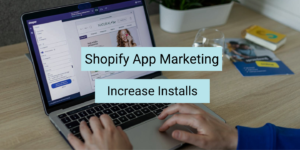Content Advertising: How To Maximize The Impact Of Your Content Marketing Efforts By Leveraging Paid Ads For Distribution
Here’s a quick refresher on the state of content marketing and where it stands in 2021: every single day, more than 4.4 million blog posts are published, 98% of B2B marketers and 96% of B2C marketers invest in content marketing, so if you’re into leveraging content as part of your inbound marketing efforts, congratulations! Well, not so much, because creating content alone isn’t going to bring in the results for you.
You are not going to get new leads, conversions, and beyond overnight, so your best bet to tread forward is to snap out of this misconception. For your content marketing efforts to create an impact, and a tangible one at that, you need to be able to look at the whole nine yards, and act accordingly. This is where the concept of Content Advertising comes into the play.
Hence, it would benefit you as a content marketer, inbound marketer, or a digital marketer to learn the ins and outs of this nascent science by educating yourself. So, let’s get started with it, shall we?
What Is Content Advertising Anyway?
It might sound a little surprising, but the precise definition of content advertising is a bit challenging to pin down in its entirety. What really makes our teeth itch is the fact that a lot of people (quite understandably) end up confusing content advertising with content marketing. And paid advertising. And content strategy. And performance marketing. Ugh, so wrong.
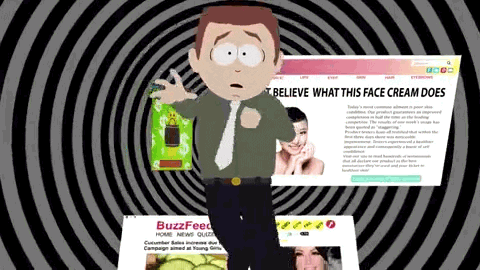
Even though the concept of content advertising as a practice is really new, the basic premise behind the idea is really simple. According to Wordstream, it goes something like this:
“Content advertising is the process of producing content with the intention of promoting that content through paid distribution channels. This can include PPC campaigns, paid social, sponsored placements, and any other type of paid promotional opportunities anywhere online.”
When it comes to content formats, really any of the ones in use out there can be produced to be a part of a content advertising campaign: blog post, eBook, webinar, decks, and so on.
For example, you could create an industry report focusing on a problem common to prospects and customers in your domain, with the intention of promoting the same through paid ads on social media channels such as Twitter, Facebook, and LinkedIn. As long as the content being produced is to be promoted via paid distribution, you’re making use of the concept of content advertising.
Examples of content advertising at play
1. Drip
Drip, the email marketing software uses their Linkedin Ads in a really good way by promoting content around their personas’ pain points and needs. Oh, and who thought the colour pink could look so pretty and captivating in a graphic? Kudos to the drip design team for hitting bingo on this one! 😀
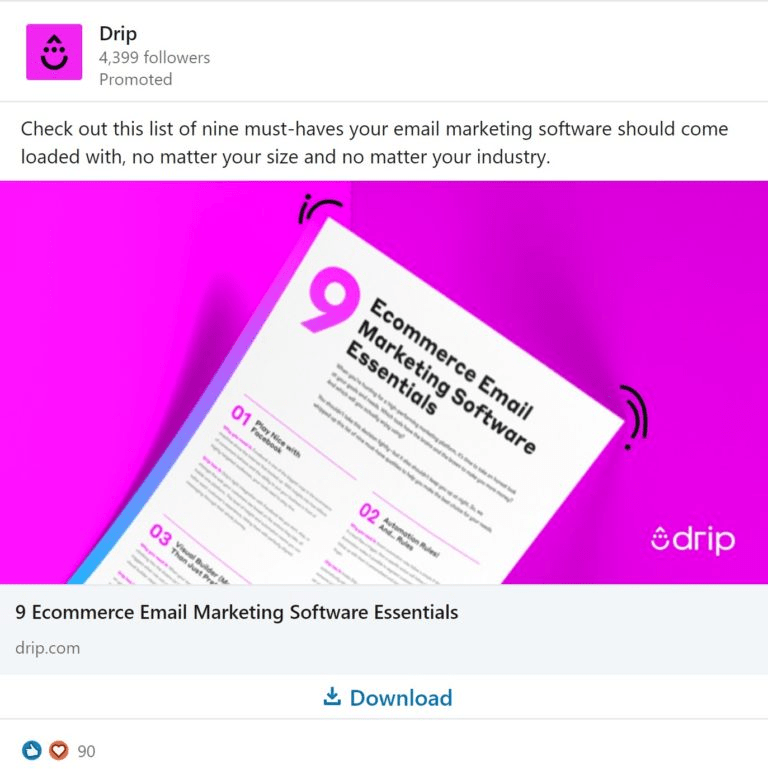
2. Klarna
Klarna shows us how a simple, minimalistic ad to promote your content could be both captivating and impactful at the same time. If there’s one thing they could have done away with though, is to not have the Download Now button look like a button in their illustration, because you know, it’s not really a button.
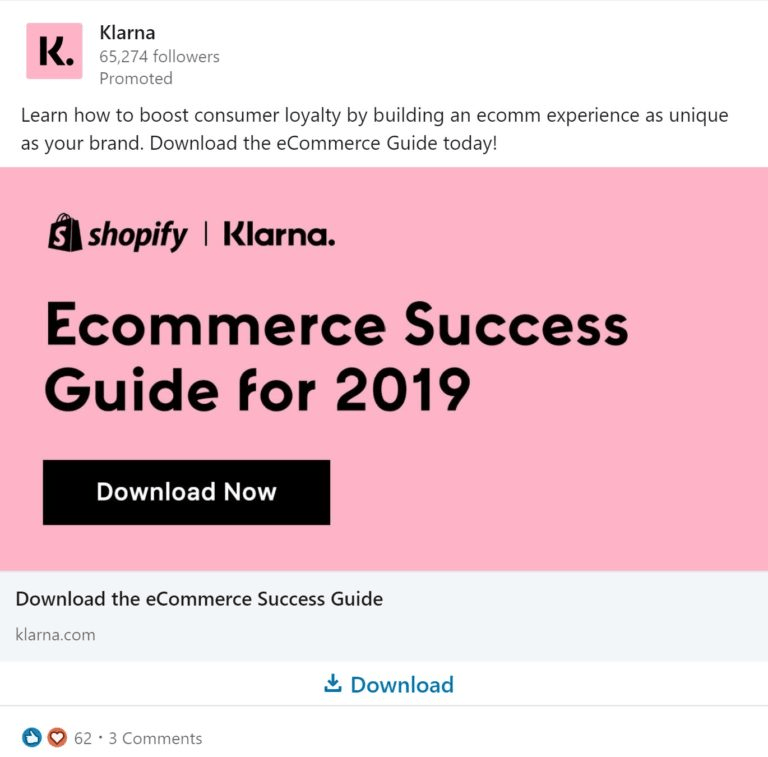
3. Stripe
If a SaaS behemoth like Stripe is doing it, it must be worth something or at least exploring. In their content ad, Stripe promotes a webinar as the content format, and does an overall job at everything from the copy, to the graphic, and more!
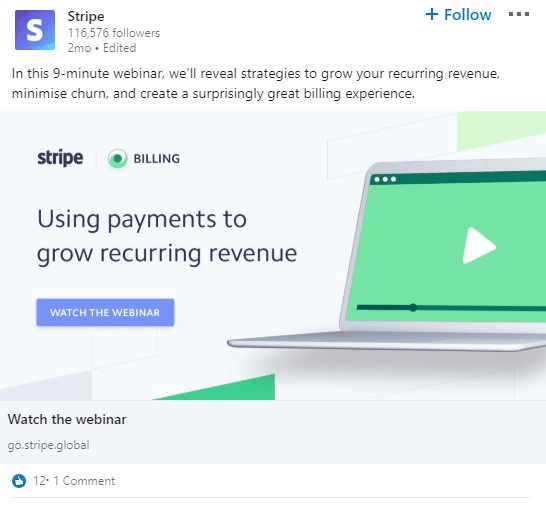
Hey, but wait, isn’t the whole idea of content marketing to help my brand grow ‘organically’?
Well, here’s the thing, in a way, yes. But consider this: focussing just on getting your content marketing efforts to create an impact organically can take a lot of time, anywhere from three to six months, and even longer (depending on your strategy).
Moz claims that on an average, it takes about six months for your content to produce any considerable results from an organic point of view. Now, would you be wanting to wait that long just to save a few costs?
Or would you be rather more inclined towards giving your content a springboard to create the same kind of results, even faster? We thought the same. And hence, this piece.
Why shouldn’t I just run regular paid ads instead of running ads for my content?
Here’s the thing, the whole reason your marketing function exists is to help your target audience find you. Now, there needs, expectations and pain points (which by the way, your business exists to solve for), do not change basis your decision to remain organic or invest in paid ads.
They still want to be educated about something before they commit to it. And that’s how blending your content marketing efforts with your ads helps you maximize its impact. If you think a direct push of your product or service along with a flat discount is good enough, snap out of it.
Surely you have heard of the content marketing funnel, right? How the stages go from attracting, to educate, to convert, and beyond. Well, your content advertising also needs to move in a similar fashion. Unless you’re selling a product which sells regardless of how good or bad your marketing is, like Apple’s iPhone, you can’t expect people to be ready to pay up dollars without them being sure it will add value to their life in some way or the other.

Content Advertising vs. Content Marketing: There’s A World Of Difference
There is no need for us to reiterate the benefits of content marketing, you are well aware of the same, without a doubt. But how does content advertising differ from traditionally practised content marketing in the first place?
In actuality and the larger picture, the phrase content advertising can be considered to be a bit of a misnomer. After all, content marketing is a core part of inbound marketing, which focuses on being as minimally intrusive to consumers as possible. Traditional advertising, even digital advertising done through digital marketing, on the other hand, is often intentionally intrusive and disruptive, designed solely to captivate the attention of the viewers and entice them to take a specific, certain action.
One element that is especially common between content marketing and content marketing, though, is an exceptional emphasis on quality to be able to make a tangible impact. Just because you are spending money to distribute or promote your content through non-traditional, paid channels doesn’t mean your content can be any less useful for your audience than your “organic” content. If anything, the quality of your paid ads’ content should be even higher, since you’re already investing so much in it in terms of capital.
Moreover, and this is a really important one, just because you are going to promote your content via paid marketing channels such as search, social media and so on, does not mean at all that you should resort to sleazy, often disruptive tactics favored usually by traditional advertising done on TV, radio etc. You know that your audience deserves, and expects (read demands) better. Doing so can easily dissuade your prospects and tarnish your brand image to a great extent, even if what you’re promoting in your content is of high enough quality.
Another big difference between content marketing and advertising is the fact that content marketing usually relies on SEO, organic-based efforts to rank, whereas, content advertising, on the other hand, overcomes the issues of organic reach being not sufficient by taking advantage of paid promotional channels’ benefits, such as highly granular segmentation of your target audience.
In a nutshell, there are drawbacks of relying solely on organic traffic to get the most impact out of your content marketing efforts, thanks to the ever-increasing competition, among other things. It could be easily argued that content advertising is the future of efficient marketing of content, and to reach business goals through these efforts.

Why Do I Even Need Content Advertising In The First Place?
Before we discuss this any further, consider this scenario: you are running ads on your LinkedIn, Twitter, or Facebook account through a perfectly targeted and optimized campaign. Basically, you do everything there is to do right, but one thing: build your ads on the back of a great, engaging piece of content that perfectly aligns with the issues faced by your target audience (like some of the examples we shared in the section above).
If you’re wondering what is going to happen next, don’t worry, we’re here to tell you exactly what, and why. In all likelihood, your cost per click (CPC) will increase exponentially, and your rate of engagement for the said campaign is most likely to plummet. All in all, you will end up blowing your money for no good.
The same goes for all paid marketing channels out there or any paid promotional activity for that matter. Without offering valuable content to direct to people who click on your ads, your opportunities to get new leads without offering a lot of discounts or special promotions will be excruciatingly limited.
So, we’ve established that content can be limited without taking advantage of all the paid channels out there, but also, that paid channels can be limited without great content. The answer to your puzzle is to leverage them both for the maximum impact on your business.
What are the advantages of content advertising that make it worth exploring?
One of the most primary, the biggest benefit that content advertising offers to marketers over content marketing is that content ads do not rely on search engine algorithms or organic discoverability, not even in the slightest. When you are spending money to promote a piece of content on any platform, you do not have to worry about making the content generic to appeal to a larger audience, or trying to appease the crawler to make an impact to rank. Just by simply finding your audience, and using whatever distribution channel best fits the bill, you are ready to get started with your content advertising efforts.
Another big advantage of the concept of content ads is that it empowers you to explore topics with a laser focus that may otherwise be considered too specific or niche to be discovered by organic means. What this means is that with investing in content advertising, you can find and explore the specific pain points that are being experienced by your prospects (and audience at large), and tailor your content production to meet their needs in a very confident manner – positioning you and your business as a thought leader in the minds of your readers.
It is also possible to make content ads initiatives and programs scale remarkably well. Basis the purpose of the content and the prospective audiences you build, it is super efficient to leverage a number of paid marketing channels to take your content in front of just the right people, at the right time. From large scale pay per click campaigns to reach a vast audience to smaller, more targeted paid campaigns across social media that deliver great impact at very generous pricing, you can achieve it all without much of a headache.
PS. Did you read my blog on why your content marketing efforts haven’t been working?
Okay captain, but what about the disadvantages? Give me the caveats and the potential red flags
Everything in this world, especially marketing channels, have their fair share of drawbacks, and content ads as a distribution or content promotion channel do not have any exceptions in this regard. Before we dive into them, here’s a quick meme comic from Dilbert to set the mood right:

Although it is not just unique or new to content advertising alone, the problem of creating quality content in the first place is a constant one for advertisers. Even if someone is an expert in their field, there is a very real-time overhead involved when you consider producing quality content on a consistent basis, and there are only so many hours in a day and so many days in a month.
While hiring freelance content people to ease up the increased workload comes with its own economic pursuits, one that only ends up compounding problems for companies considering content advertising with limited resources in the first place.
It has been argued by experts and influencers that content ads projects can scale up remarkably well due to paid marketing’s inherent flexibility, this also means that your total addressable reach could be limited by the money you have to spend available in your bank.
Paid social media marketing on platforms such as Facebook ads, offers an exceptional return on investment for marketers with smaller budgets, but if you have aspirational goals for your business, content ads may not always produce the impact you would need to justify the input costs given the lengthy journeys involved in a general content conversion funnel.
On the same lines, the ability to target niche topics without worrying about discoverability can bring on its own set of problems for content marketers. The smaller your audience gets, the higher conversion rates should be to be able to justify the campaign in the first place, and that is something which isn’t always possible.
Over a long enough timeline, the rule of diminishing returns means that some projects may be too niche for you to justify the costs of producing and promoting the content in the first place. Smaller prospective audiences also present greater challenges with regard to segmentation and targeting to them – you can divide a small number of people only so many times before you risk alienating them by blowing ads for your content in their faces.
How To Get Started With Content Advertising
We understand that leveraging paid traffic with valuable, relevant content can help you stay clear of some of the most common pain points that can pop up when you go about running a campaign using just one or the other. But, getting started can seem really tough if you have not gotten your hands dirty before. So, how exactly do you identify what you need to do first?
About 99% of marketers out there will agree with us when we say that your content comes first. You first need to figure out what is the strongest piece of content you have to offer to your target audience and work your way back from there.
But that’s not all, and we are here to help. Following are the steps you need to take to nip this whole content advertising thing in the bud. And if you’re ever stuck anywhere, just make sure to trust your gut, and you will be good to continue.
Step 1: Identify The Channels That Perform The Best For Your Marketing Strategy
The very first step in your journey to ace content advertising is to identify the best mix of paid marketing channels you have the best shot at for generating results out of your campaign.
As a rule of thumb, you would want to pick the same channels which are already giving you the results in your paid marketing strategy, as it will only help solidify your footing among already established prospects for your business.
However, if you want any new paid channels to be introduced into your paid marketing mix, now would be the best time to explore what those channels are, and how you could go about setting them up for the next steps.
Step 2: Identify the Best Content for Your Chosen Paid Channels
Once you have a list of (or just one) paid channels identified for your content advertising efforts, the next thing on your list – and arguably the most important one for that matter – is for you to identify the content that you would want to be promoted.
Here, you should do a comprehensive audit of your content library, and feel free to pick and choose any content pieces that have done well previously, align well with your prospects’ pain points, or anything else, the choice is yours as long as you are confident you won’t end up boring your readers.
Step 3: Segment The Content Basis Your Funnel Stages
Let us say by now you have about ten of the best content pieces you have ever created, regardless of the format and platform. Your next step is to segment these pieces of content based on the stage of the funnel they solve for your prospects and audience, akin to how you have other marketing activities aligned to them.
Marketing funnels can be aplenty, depending on how you chose to configure them for your business’s use cases, so don’t fret if you are having trouble aligning them to the T, just make sure you have a good gut feeling about what content to offer when.
Step 4: Repurpose The Content To Be Used In The Paid Ads
Ah, back to the drawing board. Here, you want to repurpose the content pieces you have to fit the platform you are going to target your audience on so that it looks relevant. Now you would want a slide deck to be shared to your audience on Facebook, right? Nor would you want a meme to be posted for your prospects on LinkedIn.
Come to think of it, repurposing this content has a high reward and low effort involved since you would not be doing this from scratch. So all in all, this step should not take much of your time in the first place, right?
Step 5: Run Ads For Your Target Audience And Also Retarget Your Visitors
And now, finally, you have the liberty to go ahead and execute the final step, the final nail in the content advertising coffin (ok, sorry, not sorry). Here, it all depends on how you want to optimize, budget, plan and manage your content advertising program, as it all depends on what your end goal with the campaigns is. Basis that, you should be able to choose for how long you want to run the campaigns, and how you would measure its success.
Maximize The Impact Of Your Content Marketing Efforts, Starting Today
Now that we have explored the ins and outs and received a low down of the nascent art and science of content advertising, it is safe to say that you can go out there and build a content advertising campaign for your brand. It might seem a little overwhelming at first, but there is always a first time for everything, would you not agree?
Just keep in mind that there are no fixed rules when it comes to marketing, so whatever you do, there is no right and wrong. Only wins and learnings. On that note, happy content advertising!

